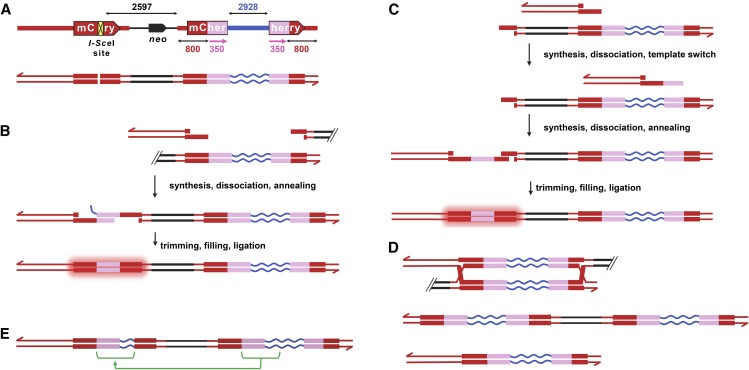Figure 2.
An SDSA assay for human cells. (A) Schematic of the assay construct. The mCherry coding sequence is represented with a large arrow, with the yellow box indicating the site at which a 350-bp fragment was removed and replaced with an I-SceI site. The thick red lines designate the promoter and 5′ and 3′ untranslated regions. Downstream of mCherry is the neo selectable marker and vector sequences (black arrow and line, respectively). The repair template consists of 800 bp of homology to the left of the DSB site, then the 350-bp deleted fragment (magenta), a 3-kbp spacer (blue), another copy of the 350-bp fragment, and 800 bp of homology to the right end of the DSB site. The lines below are a representation of the same sequences as duplex DNA, for use in subsequent panels. Arrowheads indicate 3′ ends at the outer edges of the construct in all panels. (B) Two-ended SDSA repair. The DSB is shown as resected and paired with a template. This diagram shows interchromatid repair, where the template on the sister chromatid is used (whether or not it was cut by I-SceI). Intrachromatid repair may also be possible; in this case, the black lines to the right of the DSB would be continuous with those to the left of the template. After strand exchange, synthesis into the 350-bp regions, and dissociation, complementary sequences can anneal. In the example shown here, the left end has been extended through the 350-bp fragment into the spacer; the right end synthesized only midway into the 350-bp fragment. After trimming of the spacer sequence, filling of gaps, and ligation, a restored mCherry is produced, resulting in red fluorescence. (C) One-ended sequential SDSA. This is similar to (B), except only the left end of the DSB has paired with the template. After synthesis and dissociation, the nascent strand can pair with the second half of the template. Additional synthesis can extend the nascent strand to provide complementarity to the other end of the DSB, allowing annealing and completion of SDSA. (D) If one or both ends invade the template and synthesis traverses the entire template, a dHJ can form (top). If the dHJ is dissolved or resolved in the noncrossover orientation, the product shown in the middle is generated. The bottom part of this panel shows the chromosomal product of crossover resolution (there is also an acentric extrachromosomal circle that will be lost). (E) A product produced by initiation of repair by SDSA but completion by end joining. In this case, part of the spacer has been copied into the upstream mCherry (sequences from the template are indicated with green lines).

